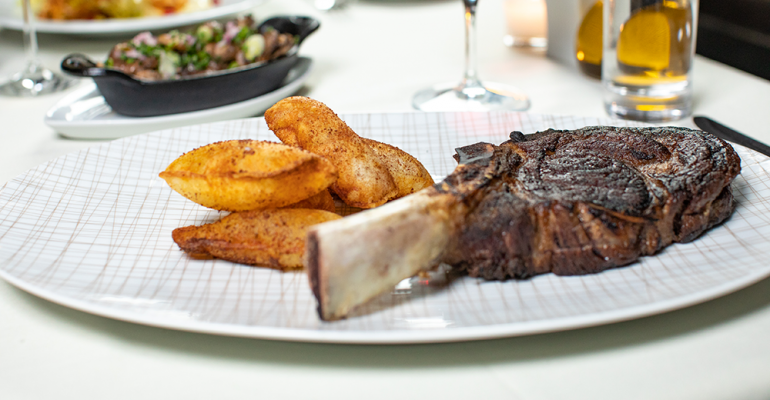Richard Farnabe has been quietly running some of New York City’s finest kitchens for decades. But in February he took on a new challenge: Following Jewish dietary laws at Reserve Cut, a kosher steakhouse in Manhattan’s financial district.
“There’s a rabbi in the kitchen and we only order what we’re allowed to order,” Farnabe said, adding that it’s really not that complex. “No dairy or shellfish [or pork] and you’re good to go.”
Well, and a couple of other things are banned. Although fruit and vegetables are kosher by default, the particular rabbi at Reserve Cut doesn’t like raspberries and blackberries that can harbor hidden non-kosher insects.
But, apart from American-style steak, Farnabe’s menu is largely Mediterranean, meaning he doesn’t need to worry about cooking with butter, which would violate the ban on eating dairy with meat in the same meal, because he mostly cooks with olive oil.
For dessert, coconut milk has proven to be a fine substitute for cow’s milk in pastry cream. Coconut cream, the fat in coconut milk that floats to the top, can be whipped just like cream for desserts.
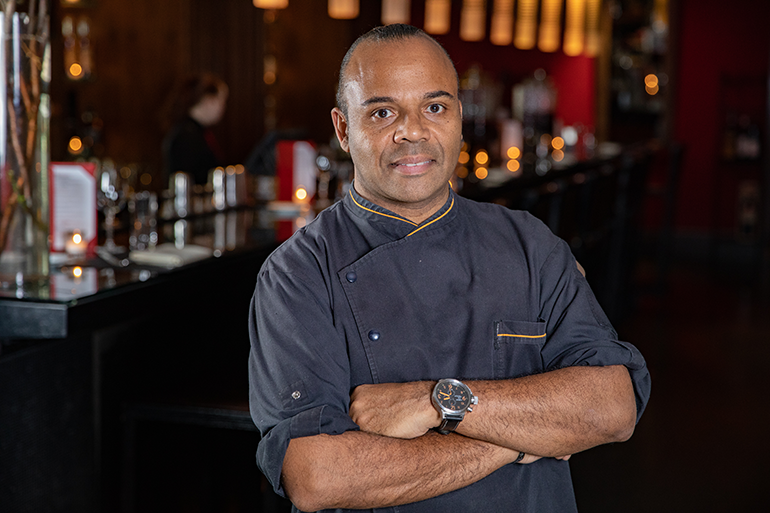 Michelin-starred chef Richard Farnabe (Photo: Reserve Cut)
Michelin-starred chef Richard Farnabe (Photo: Reserve Cut)
Farnabe started cooking in New York kitchens 24 years ago, after he already had 20 years under his belt in France.
Born in Paris, Farnabe came from the Bouchard family of wine producers on his mother’s side — his father died before he was born. His mother often worked late and gave him money to go to the market and cook for him and his brother. His love for cooking sparked, Farnabe did a classic French apprenticeship, followed by studying cooking in hotel school and working for 10 years under chef Jacques Maximin.
That was all well and good. And at the time, in the early 1990s, Paris was still the global center of fine dining. But Farnabe wanted to go to America.
“I understood that if I wanted to grow and expand myself, I’m not going to be able to stay in France to do it,” he said. “I wanted to understand what Americans like to eat, and how they eat.”
Maximin arranged for him to work under Daniel Boulud, who had left his job at one of New York City’s hottest restaurant at the time, Le Cirque, and opened his own restaurant, Daniel. Farnabe joined him there in 1995 and worked there for two years before another French chef, Jean-Georges Vongerichten, hired him away to open Jean Georges restaurant, which reflected Vongerichten’s approach of incorporating Southeast Asian influences into classic French technique. Vongerichten then put Farnabe in charge of Mercer Kitchen, where he was executive chef until he began splitting his work between three jobs.
In the morning, Farnabe was the personal chef of fashion designer Tommy Hilfiger. Then, once he had made lunch for him, he would go downtown to Montrachet, a fine-dining restaurant in Drew Nieporent’s Myriad Restaurant Group. Farnabe was a consulting chef for the group at the time and had installed the Montrachet’s executive chef, Harold Moore, who had been Farnabe’s sous chef at Mercer Kitchen. Then at 8 p.m., once dinner had been prepped, Farnabe went to a trendy club-like restaurant called Lotus, where he was executive chef.
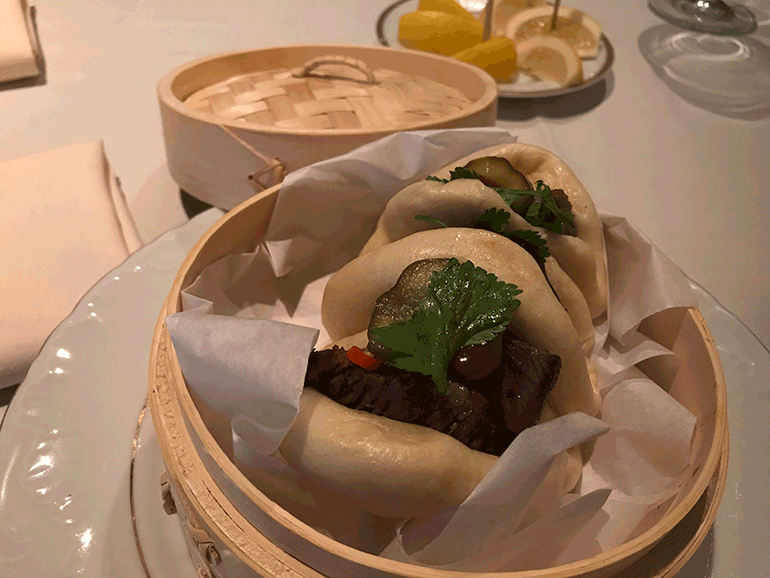 Reserve Cut's wagyu short rib bao and a dessert sampler (counter-clockwise from left, caramel chocolate tarte; molten chocolate cake; peanut butter ice cream with melted chocolate; chocolate sundae with caramel, peanut, vanilla ice cream and hazelnut chocolate mousse. All are non-dairy, made with coconut milk, coconut cream and margarine. (Photos: Bret Thorn)
Reserve Cut's wagyu short rib bao and a dessert sampler (counter-clockwise from left, caramel chocolate tarte; molten chocolate cake; peanut butter ice cream with melted chocolate; chocolate sundae with caramel, peanut, vanilla ice cream and hazelnut chocolate mousse. All are non-dairy, made with coconut milk, coconut cream and margarine. (Photos: Bret Thorn)
“Tommy Hilfiger was very healthy food. Montrachet was French — very fine dining — and Lotus was very Asian-Oriented,” Farnabe said.
During those first years in the United States, it became clear to Farnabe what was different from cooking in France.
“Customers in France go to eat what the chef cooks. Here in New York, chef cooks for the customer,” he said.
“At Daniel, guests used to come with their own dressing, or they would tell Daniel how to put the salad on the plate or the way they like their meat or whatever it was. I worked in France for 20 years and never saw a plate come back to the kitchen.”
Once Farnabe’s 6 a.m.-to-2 a.m. days had run their course, he took a corporate job with the fine-dining Greek concept Estiatorio Milos, which at the time had two locations, in Montréal and New York. He worked on menu development for them, as well as on the opening of Milos’s third location, in Athens.
Next, Farnabe learned about steak on Long Island, where he opened a steakhouse called Prime for the Bohlsen family in Huntington, N.Y.
“They spent $17 million on this super-beautiful restaurant [like] I never saw after Jean Georges,” Farnabe said. “I had a $2 million kitchen.”
He brought classic French technique to the steak, serving it with pommes soufflées and classic sauces like Béarnaise and sauce au poivre, got rave reviews, including being named the best restaurant on Long Island, and then moved on to another well-reputed New York City restaurant, Picholine.
Farnabe said Picholine’s chef-owner Terrance Brennan had a specific mission for him: “He wanted a second Michelin Star.
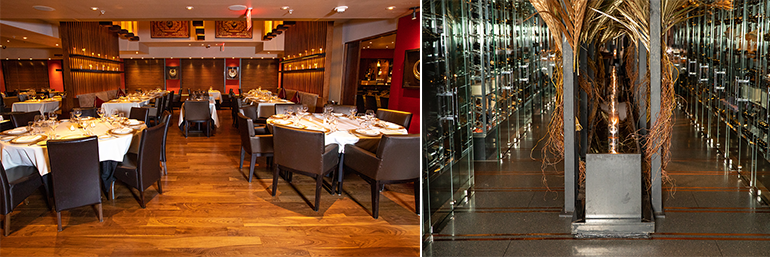 The dining room (left) and the wine gallery, a private dining room where Reserve Cut's kosher wine is stored. (Photos: Reserve Cut)
The dining room (left) and the wine gallery, a private dining room where Reserve Cut's kosher wine is stored. (Photos: Reserve Cut)
“It was a tough job, with two chefs in the kitchen. There were fireworks every day,” Farnabe said. “We argued about recipes, about how to organize the kitchen — ‘I want the duck like this,’ ‘No, the sauce is too acidic,’ stupid little things — but in the end we got two Michelin stars.”
Next he was in charge of the food at three hotels — the Soho Grand, The Tribeca Grand, in those respective Manhattan neighborhoods, and the Sheraton in Jersey City, N.J., which were all under the same ownership.
Then they were sold to three companies.
“My position was not available anymore, so I had to call Mr. Petrossian,” Farnabe said.
He knew the caviar merchants from his time in France, and they were looking for a chef at their Petrossian Restaurant in New York, a job that Farnabe took until the location closed two years later. After a year-and-a-half of consulting he ended up at Reserve Cut.
Now Farnabe is bringing all of his experience to bear at Reserve Cut. His steak is a reprise from Prime, and other dishes reflect his training with Asian ingredients, such as the steamed buns stuffed with Wagyu short ribs confited in bone marrow fat and accompanied by pickled cucumber and soy sauce.
Other dishes include red snapper with ginger in a kaffir lime leaf broth, and fish Wellington with a vin jaune sauce.
At lunch, he serves a chicken po’boy sandwich. “We use the same technique [as a shrimp po’boy] and we change the ingredients,” he said. Dark-meat chicken replaces the seafood, and instead of marinating the chicken in buttermilk he uses soy milk, which it turns out is acidic enough to tenderize the meat.
Fundamentally, it just comes down to cooking the way he always has.
“We use straightforward recipes and do it the way it’s supposed to be done.”
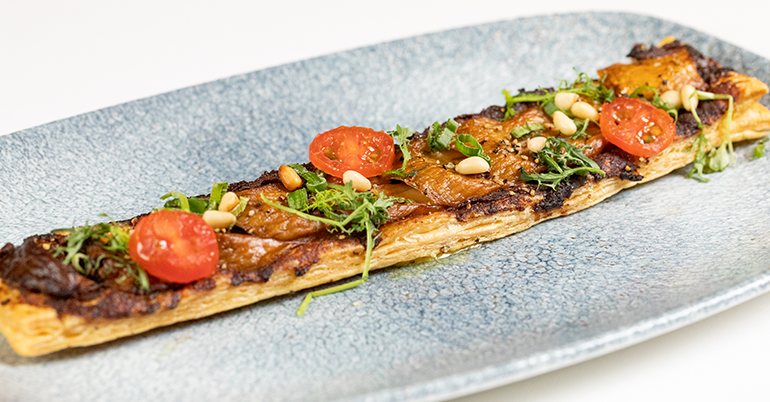 The LA Surprise Flatbread (mushrooms, caramelized shallots, heirloom tomato, petite herbs and beef bacon). (Photo: Reserve Cut)
The LA Surprise Flatbread (mushrooms, caramelized shallots, heirloom tomato, petite herbs and beef bacon). (Photo: Reserve Cut)
Contact Bret Thorn at [email protected]
Follow him on Twitter: @foodwriterdiary

